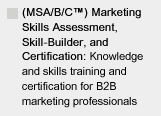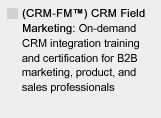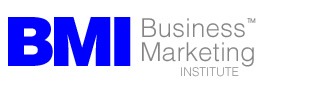MAKE SURE YOU CONTINUE TO RECEIVE EACH ISSUE OF TUESDAY MARKETING NOTES—CLICK HERE TO RENEW YOUR FREE SUBSCRIPTION
Tapping Industry Issues and Trends for Effective Content-Based Marketing Programs
by Eric Gagnon
Previously, we've described the concept of "show what you know," the core principle of developing content-based marketing programs to address the issues, trends, and motivations of prospects in your industry. This week, we'll address the issue of how to get ideas for effective content for use in lead generation and lead development.
To utilize content effectively in your marketing program, it helps to identify the issues and trends in your industry, link them to your product (or applications involving your product), and then tap the people inside your company who can comment and add perspective on these issues and trends.
Should you limit the scope of your editorial content to issues and trends? Of course not. While working through the process of uncovering content sources within and outside your company, you’ll discover all kinds of additional content ideas, such as novel applications of your product used by customers, or information on new processes and technologies in your field that are just over the horizon, but also likely to be very interesting to prospects. There is much content waiting to be uncovered within your company that you can use to sell your product, and much of it can be put to work in your ongoing communications with prospects in your lead development program.
Sources Within Your Company
To begin the process of finding content sources, start with sources inside your company:
Senior executives: Your company’s senior executives are usually plugged in to the issues and trends shaping your industry, and can be a valuable background source of useful content for your editorial messaging programs. Experienced managers in your company are well aware of the pressures they face from their changing business environment. They know, and are likely to have strong opinions and insights on, many important topics that you can turn into valuable content of interest to prospects:
• Business trends in your industry, and how these trends are likely to affect your customers and prospects;
• “Big picture” evaluations of customer experiences using your product, vs. your competitors’ products;
• Legislative and regulatory news and developments;
• Contact referrals to consultants, industry analysts, and other third parties who can become trusted content sources
Technical and product development staff: Your company’s technical and product development staff are, of course, closely tied to your product, and can provide you with valuable background related to your product that adds tremendous depth to your product’s “story” for potential buyers in your lead development pipeline:
• Product applications-related information, such as insight on product features, capabilities, and problem-solving features and benefits of your product;
• Insider viewpoints of key new product features: User or customer needs that sparked their development, what challenges or obstacles had to be overcome to develop the new feature, and other interesting facts relating to the “story” of these features;
• Insight and further details on the technologies and processes
underlying your product, such as new manufacturing capabilities required to exploit these new processes
Sales, service, and customer support: Your company’s field sales, customer service, and support teams can provide you with valuable, street-level information on how current customers are using your product:
• Background research for case studies showing how customers in various businesses and industries are using your product or service to solve their problems, and the generalized advice your prospects can draw from these examples to help their own buying process;
• Profiles showing specialized business or technical issues faced by your customers in a single, specific industry, and how using your product helps them improve their operations by addressing these issues;
• Instances where customers adopted your product after using a competitor’s product, with details on reasons why the customer switched from the competitor’s product to yours
Of course, trade publications and trade associations are also useful sources of information on trends and other industry topics. You can identify news of industry events, trends, and other items, and adapt them to your own editorial messaging program by documenting your product’s relevance to the news or event. At a minimum, you can collect links of relevant news items for compilation into ongoing news features to create an e-mail news briefing service for prospects, for example.
Apply all of what you’ve gathered from your contacts, and, where applicable, relate each of these pieces of information to an issue, trend, or motivation in your industry, and you have the makings of an engaging information feature you can use in your own editorial messaging program.
B2B Editorial Examples
Here are some additional, specific examples of focused editorial applications that can be used in lead development programs for specific industries:
• A national chain of commercial auto body collision repair centers serving the insurance market produces a five-part Web video tutorial outlining a new, systematic visual method for vehicle inspection techniques for collision and accident damage estimators;
• A company providing online pre-employment background screening services to HR managers in large corporations publishes a four-part white paper series documenting steps to take to avoid potential legal liability when making hiring decisions;
• A company selling steel highway sign fixtures to Federal, state, and
municipal prospects offers an independent research report (with an attached executive summary) on the effects of long-term sun, wind, rain, snow, salt, and weather effects on highway signage, support structures, and other steel traffic products;
• To offset plant managers’ concerns over costs and implementation of their breakthrough technology, a manufacturer of adhesive coatings application systems publishes a series of case studies, including actual production reports documenting installation, efficiencies, and savings gained from implementation of its new coatings application process
Highly relevant editorial content, focused on the needs of your prospects, is an invaluable aid to your company’s sales team in your lead generation and lead development programs. By influencing prospects over time, your editorial messaging program works to help prospects see your company less as just another potential vendor trying to sell to them, and more as a provider of the solution to their problem. Your editorial messaging program also helps prospects discover useful new issues that help them in their buying process, which also helps to move your product to the forefront in the prospect’s final purchase decision.
Comments? Questions? Send them to me at: eric@businessmarketinginstitute.com
Eric Gagnon (eric@businessmarketinginstitute.com), a director with the Business Marketing Institute, is author of The Marketing Manager’s Handbook and The CRM Field Marketing Handbook.







